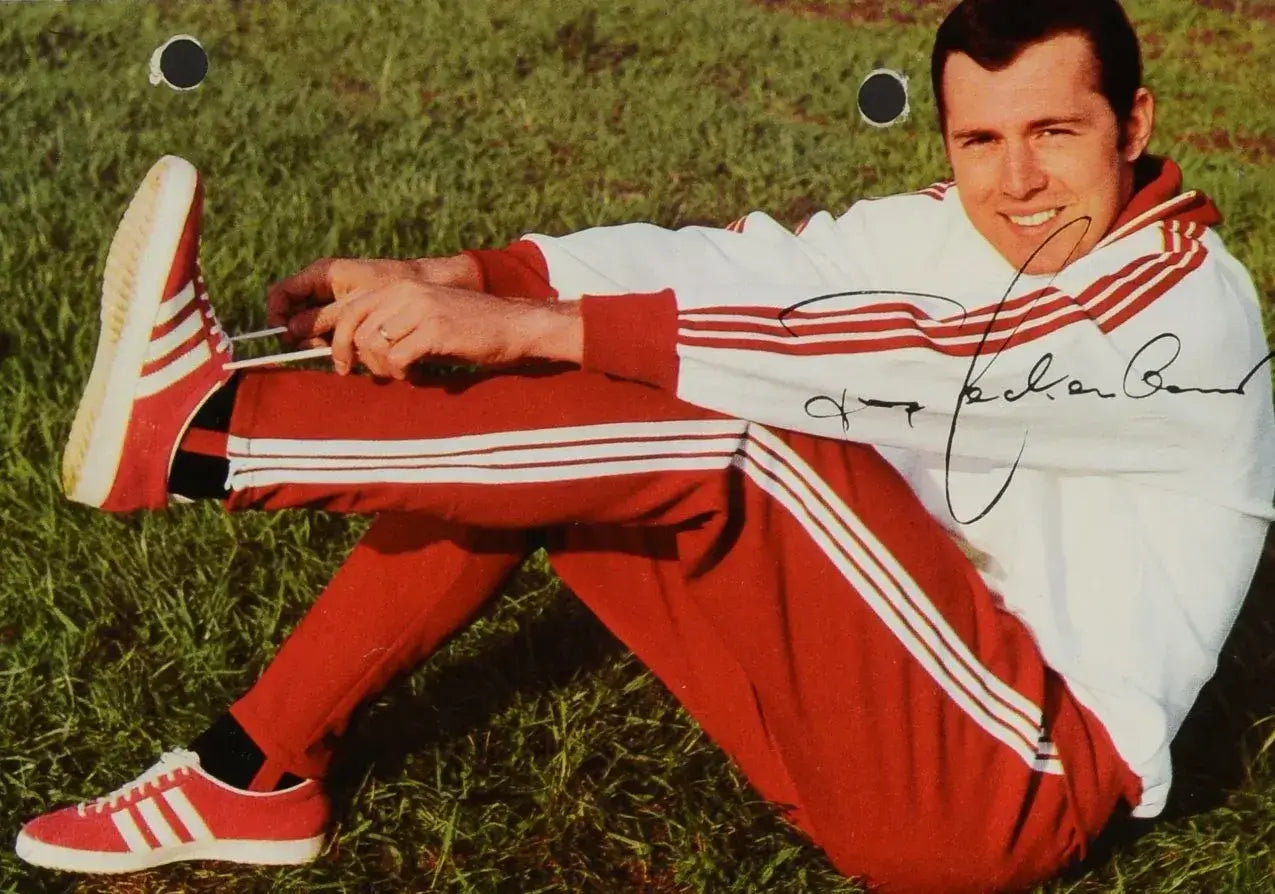They keep us warm on the couch when it’s cold outside. They make us feel comfortable when we’re bloated. Sweatpants, we’re all thankful for them - either at home or when doing sports. And while there is a school of thought against this, they’re also worn by many outside of the home now too: either casually, for chores, or dare we say - styled up to meet friends! Today, sweatpants are so widely appreciated that there’s even an international sweatpants day to celebrate them. And with anything this important in our lives, it’s worthy of a historical stroll. So let’s head off into the history of sweatpants:
- 1920: The first sweatpants, designed for athletes
- 1930s: The first tracksuit: sweatpants + sweatshirt
- 1960s-70s: Sweatpants swagger into the casual wardrobe
- 1970s-90s: Hip-hop makes a star of sweatpants & tracksuits
- Today: are sweatpants finally acceptable?
- Future: sustainability will be indispensable

1920: The first sweatpants, designed for athletes
Over 100 years ago in 1920, sweatpants were first invented for athletic purposes. The first pair was created by the founder of the French sports store Le Coq Sportif, Émile Camuset, for the purpose of comfort and the ability to run and stretch with ease. For quite a few decades, these pants continued to be associated with sport, after becoming a standard choice for athletes by 1936. They were worn by Olympic athletes and even NASA astronauts for training. In fact, according to Shaun Cole, a cultural and fashion historian at the London College of Fashion, “they were popularised as ideas of health and an athletic body became more fashionable”.
The first pair of sweatpants was simple, grey, baggy, and made with a jersey knit fabric (originally wool, and soon after cotton), which gave elasticity and softness. It’s interesting that this description could describe the sweatpants we find today, too. Yes, it’s true that there are a wide variety of sweatpants now, and there has definitely been some evolution in features, but you can easily find classic ones that aren’t too far off from the 1920s originals.
1939: The first tracksuit: sweatpants + sweatshirt
In 1939, Le Coq Sportif also invented the tracksuit: a combination of sweatpants and a matching top. Initially known as "The Sunday Suit", the tracksuit was created as the outfit for relaxing at home or doing exercise. It was Adidas, however, that made the tracksuit an icon when it was released in 1967. At the time, Adidas was a famous brand but exclusively a shoe company. The founder’s son created the first tracksuit while experimenting with clothing in the French market. These sweatpants (or trackpants) were made from nylon, a synthetic fibre, as compared to the original sweatpants which were made from wool.

The footballer Franz Beckenbauer endorsed the tracksuit into a must-have training accessory.
1960s-70s: Sweatpants swagger into the casual wardrobe
Sweatpants began to emerge as a form of casualwear starting in the 1960s and 1970s. Around this time the piece of clothing was associated with youth culture; university students and hippies. But that doesn’t mean that such trousers were socially accepted. Only in the 1980s did it become semi-acceptable to wear sweatpants for purposes outside of sports. And the reason why sweatpants became so accepted in a leisure context is because of the growth in popularity of health and fitness in the 80s. Athletes were at the centre of attention and sweatpants became less stigmatised. Being fit (or looking fit) was ‘in’.
But it was also thanks to the birth of hip-hop culture that sweatpants took off as leisurewear - and streetwear.
1970s-90s: Hip-hop culture and tracksuits
Hip-hop culture, which shook the world in New York in the 1970s, has a starring role in the history of sweatpants and tracksuits.
Run-DMC, an American rap group widely regarded as the Kings of Hip-Hop, wore the Adidas tracksuit in a 1986 music video and from this moment on, the tracksuit became synonymous with hip-hop. Adidas endorsed the group and that was the start of hip-hop’s official relationship with the sports industry. Many other rappers began to follow suit and brought the street style to mainstream audiences.
Hip-hop’s street style, which includes tracksuits, sweatpants, and myriad other pieces of attire, changed fashion and the world. It helped sweatpants to disrupt mainstream wear and even infiltrate the luxury end of the market.

Yet, a constant battle for acceptance
Throughout this tough battle for social acceptance, there’s been an omnipresent debate against sweatpants being worn in a leisure context. This piece may have given us the utmost comfort but negative perceptions towards sweatpants as a sign of laziness have persisted - which is ironic since they were designed for sports. They can also be considered scruffy or untidy. And sometimes, inappropriate depending on the occasion.
During the pandemic, as we were getting comfortable indoors and really embracing sweatpants, this debate raged on with many wondering whether they would be widely accepted as everyday wear, at last.
And while sweatpants aren’t as popular now as they were at the peak of the pandemic - it seems we’ve reached a tipping point.
Now, an essential wardrobe piece
You can say it. Today, the world has just about embraced sweatpants.
Thanks to their heterogeneous history, sweatpants are an extremely versatile piece of clothing. They can be made with loads of different fabrics, both natural and synthetic. They come in different colours and designs, can be tapered at the bottom or loose, and can have a baggier fit or tighter. Since there’s a wide array of sweatpants to choose from now, the overall perception is fragmenting. Some may look more formal and others more casual; some more edgy and some more basic. Not only in terms of design are they versatile, but also in terms of style. There’s now the possibility of wearing sweatpants almost anywhere, appearing fashionable, on trend, and yes even luxurious. Sweatpants have, in a way, arrived.
The future: sustainability will be indispensable
Still, it doesn’t quite end there, now that we’re entering the age of sustainability in fashion, it’s also important to consider some of the sustainable sweatpants that are appearing on the market. After all, fashion isn’t just about comfort these days. Sustainability is now as important as anything else. It’s set to become indispensable in the sweatpants of the future.
At SANVT, we’re proud to enter the timeline with a noble pair of high-quality, comfortable and sustainable sweatpants. Here’s a little more about them…
The Perfect Sweatpants at SANVT
Here at SANVT, we’ve made the perfect sweatpants. Why? They are:
- heavyweight (400 gsm), and will no doubt keep you warm
- crafted from 100% French Terry Loopback organic cotton
- made sustainably, with natural fabric and care towards quality
- smooth, soft, and jersey-like -
- timeless minimalist style (similar to the original sweatpants)
- highly breathable due to the knit structure
- climate neutral, like all of SANVT’s garments are
- handmade in Portugal, under fair factory conditions.


